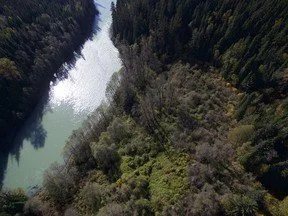Ancient Indigenous forest gardens still yield bounty 150 years later (study)
A first-of-its-kind study by SFU finds that Indigenous forest gardens filled with fruit and nut trees are still thriving, at least 150 years later
Along Canada’s northwest coast, ancient Indigenous forest gardens — untended for more than 150 years — continue to thrive. Ts’msyen and Coast Salish peoples once planted and cared for plots of native fruit and nut trees, shrubs, and medicinal plants and roots along the north and south Pacific coast, a new Simon Fraser University study finds.
Forest gardening is a common method of food cultivation and agroforestry in Indigenous communities around the world, especially in tropical regions. But the findings published in Ecology and Society mark the first time these lush, open, orchard-like plots have been studied in North America.
In coastal forest gardens, crabapple, hazelnut, wild cherry and plum trees provide a canopy, shielding plants such as cranberry, elderberry and hawthorn, wild ginger and wild rice root. Containing more species diversity than the surrounding conifer forests, according to the research, the intentionally planted patches continue to provide a significant habitat for birds, bears and pollinators.
“These plants never grow together in the wild. It seemed obvious that people put them there to grow all in one spot — like a garden,” says SFU ethnobiologist and archaeologist Chelsey Geralda Armstrong , lead author of the study, in a statement .
In their management of these ancient forest gardens, the researchers write, Indigenous peoples practiced controlled burning, coppicing (encouraging growth by cutting back trees or shrubs to ground level), fertilizing, long-distance transplanting, pruning and weeding.
Despite being unmanaged for more than a century, evidence of these historical practices can still be seen at remote archaeological villages. This resilience is the most surprising aspect of the research, Armstrong told Popular Science . “On the Northwest coast, conifer forests are stubborn. They will reestablish themselves 20 to 30 years after a disturbance.”
With such a varied mix of species occupying different niches, the researchers said, there’s less room for new species to take root. Their effective use of space — “there’s a canopy, a sub-canopy, a bush-shrub layer, a vine layer going up and around, and then a herbaceous layer” — is likely central to their longevity.
For their study, the researchers selected four archaeological sites that had been occupied for more than 2,000 years: two Ts’msyen village complexes in northwestern B.C. and two Coast Salish complexes in the southwest. (A village complex consists of two or more nearby villages, each containing five to 20 houses.) Indigenous peoples tended forest gardens on these sites until they were displaced in the late 1800s.
“Elders and knowledge holders talk about perennial management all the time,” says Armstrong. “It’s no surprise these forest gardens continue to grow at archeological village sites that haven’t yet been too severely disrupted by settler-colonial land-use.”
Read the rest of the full article here.

